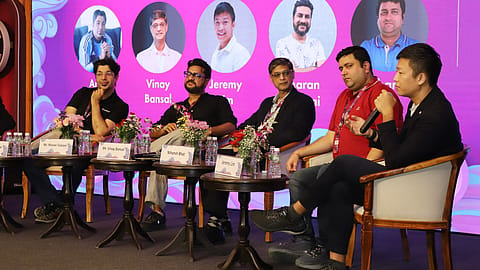VCs place big bets: India’s gaming gold rush echoes China’s golden era, say top investors at WAVES 2025
India currently has one listed gaming company—Nazara Technologies—and nearly 250 startups actively building in the space.

India is at an inflection point in gaming, echoing the explosive growth phase China witnessed in 2008, said leading venture capitalists and strategic investors at the WAVES Summit 2025 panel, “The New Arcade: VC Perspectives on Gaming’s Next Frontier.”
“If I had invested a million dollars in ten Chinese gaming startups back in 2008, I’d have made a 100x return,” said Anuj Tandon, partner at Bitkraft Ventures. “India is now at that exact same moment.” He added that India currently has one listed gaming company—Nazara Technologies—and nearly 250 startups actively building in the space. “It’s very hard to not make money if you invest smartly across 15 to 20 of them,” he added.
The bullishness wasn’t limited to Indian investors. Jeremy Lim, principal, GFR Fund, said, “India is like nowhere else in the world—you can get groceries delivered in 10 minutes, and the model works. That chaos-beneath-efficiency is exactly why India is such an exciting market. You can replicate global models with a local twist and still find success.”
Backing this view, Nihansh Bhat, who leads corporate development at Krafton India, said the publisher of BGMI, pointed to similarities in user behaviour and market evolution between India today and China in the late 2000s. “Until a point, you couldn’t find too many gaming companies [in China], and then once the spends crossed a threshold, things changed,” he said. “There were complaints that Chinese users didn’t pay—but now they’re among the highest-paying users globally. We see similar monetisation shifts happening in India.”
Bhat added that India still faces gaps in skills and execution, but global gaming players like Krafton are working to bridge them. “We’re trying to close that gap as best as we can through initiatives like our incubator programme, direct investments, and by bringing in expertise through acquisitions.”
Although, panellists agreed that India’s creative edge—its storytelling culture, large youth population, and growing digital economy—could give it an advantage China didn’t have during its own gaming boom. “We are a nation of storytellers,” added Tandon. “We have the Bollywood advantage and a history of regional narratives. Combine that with AI tools and rising game development capabilities, and you have a perfect storm.”
This blend of creativity and tech was central to the thesis of Jetapult, a firm that not only funds but also acquires and operationally supports gaming studios. “Think of Jetapult as fuel and framework,” said Sharan Tulsiani – founder, Jetapult. “We invest in studios under $5 million valuation and layer them with AI workflows to supercharge output. We’ve turned ad revenue optimisation from a founder bottleneck into a 40% lift through automation. That frees up creators to focus on games.”
Recommended Stories
According to Tulsiani, the democratisation of AI is opening the door for a new generation of game developers and we’ll see a Harvard-dropout like trend in India. “There’s a kid in Kota right now, thinking of dropping out of the IIT race, because he’s seen that with AI workflows, he can build a game solo,” he said. “We’ll see businesses built by such creators in the next 3 years.”
Vinay Bansal, founder and CEO of Inflection Point Ventures, emphasised taking early moonshot bets before building out a broader investment thesis. “We often start without a thesis—just conviction in the founder and problem. Over time, as data comes in, we back the winners at growth stage,” said Bansal. IPV has already seen exits to players like Dream11 and Zomato, and one of their gaming portfolio companies is currently undergoing acquisition.
The panellists agreed that capital alone isn’t enough. Tandon stressed the importance of resilience in founders. “In early-stage gaming, you're betting on the person. The first and second games may fail, but the grit to pivot and build the third—that’s what matters.”
As India stands at the cusp of a new era in gaming, the message from the panel was clear: the infrastructure, capital, and consumer appetite are all falling into place. What’s needed now are more stories—built by Indians, for the world.
“Don’t wait five years to start,” Lim advised. “The window for low-hanging opportunities is now.”